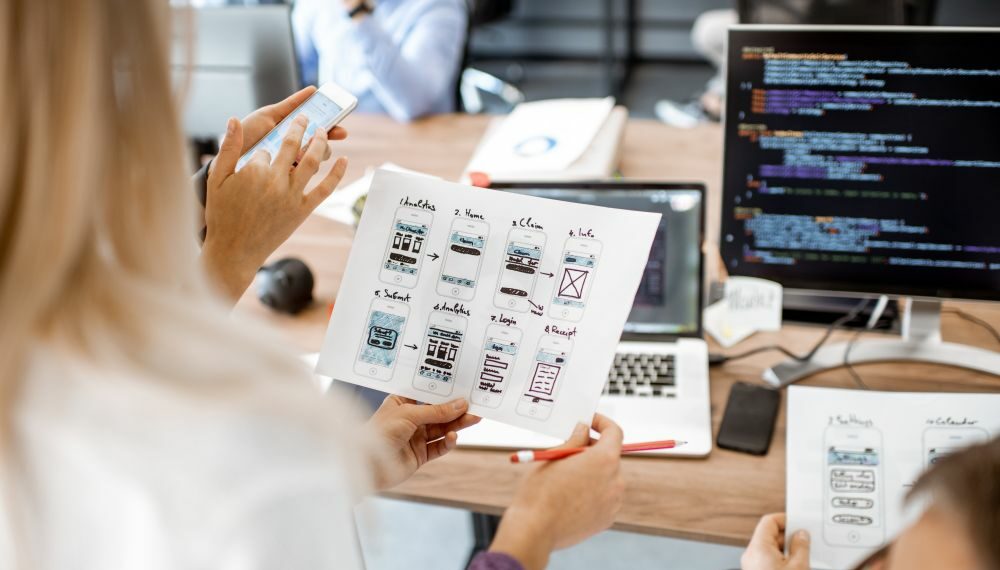What is your first thought when you click on a website and see a plain, white background, Times New Roman font, and unstructured text sections? You probably want to bounce, right?
What if that hideous page had some colour, buttons, images, spacing, and visual harmony? Would you spend more than two seconds there?
That is the importance of design. If you create an application that lacks the basics of visual appeal, you are much more likely to lose the attention of almost everyone that comes across it. On the other hand, an aesthetic design is enough to draw users in.
In this article, we discuss what app design consists of and where you should start to create optimal app designs.
The Basics of App Design
App design refers to the process of making an application both functional and aesthetically pleasing. The goal is to provide a pleasant user experience (UX) and an appealing user interface (UI) to improve user satisfaction.
App designers should always keep in mind a few principles:
- User-centricity
- Simplicity
- Consistency
- Feedback
- Accessibility
- Testing
What makes app design so important is its crucial role in building a positive user experience. A well-designed app enhances the user experience by creating a seamless experience that allows users to achieve their goals quicker, thus increasing their satisfaction and developing a positive perception of the app.
As users find joy in the app, their desire to spend time using it increases, which leads to increased user engagement, which, in turn, can lead to higher customer retention and revenue.
Understanding Your Users
Considering how important the design is to attract and retain users, it is fundamental that an app designer has a deep understanding of their target audience and what needs and goals the design must meet.
When you collect insights about user needs, preferences, and expectations, it is easier to create something meaningful and valuable to the users. You can gather this type of data by:
- Conducting interviews or surveys
- Tracking relevant metrics and KPIs
- Creating user personas of your target audience
- Developing user scenarios to identify needs and pain points
- Collecting feedback
As you develop something – in this case, a design – that addresses their pain points and helps them reach their goals in the app, you are actively contributing to their satisfaction and consequent retention.
Building App Design Elements
Visual and functioning elements of an app are essential parts of a visually appealing and user-friendly experience. In app development, designers must ensure that the top app design elements are user-centric and capable of providing a positive experience for the user by making app usage simple, clear, and enjoyable.
The crucial app design elements designers should work on are:
- User interface (UI) – the user interface has to be visually pleasant and functional.
- Navigation – an intuitive navigation system allows users to move around the app easily and helps them reach their goals quicker.
- Typography – choosing the right fonts also makes the app easier to use and influences the overall vibe of the application.
- Colour palettes – colour has a strong psychological impact. The correct colour combination helps make the app more cohesive and professional, which conveys positive emotions towards the product.
- Imagery – they make communication simpler, more straightforward, and more efficient.
Keep up with App Design Trends
When it comes to technology, old is rarely better. Designers must use trends to create more appealing and efficient designs that draw user attention. Granted, it is not easy to keep up with every single one, as both technology and trends evolve and change practically overnight. However, some trends have come to stay and significantly improve how users interact with apps.
An example of that is virtual reality. VR, which is growing in popularity as we speak, is a technology that provides immersive experiences for users. App designers can collaborate with virtual reality developers and build innovative designs that revolutionise how users interact with an application.
Conclusion
App design is a vital factor in a positive user experience. A well-designed app captivates the audience and puts you ahead of the competitive curve by providing an aesthetic and user-friendly experience that increases user engagement and retention.
To create the best design, developers must start by identifying and researching their users, to understand their needs and goals. Then, they must focus on building their app design elements according to the insights they collected. Finally, they must track app design trends that can impact their design ideas, such as virtual reality technology.






